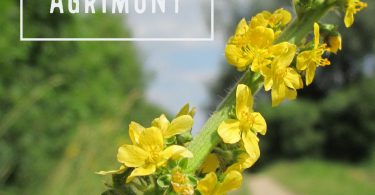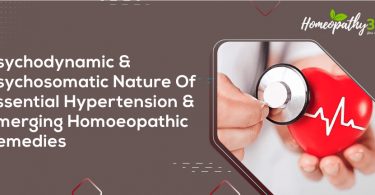
ABSTRACT: The study consisted of two parts, theoretical and practical. First theoretical part was completed by studying, collecting and compiling the data by going through extensive –literature and authentic information’s available regarding LM potency and respiratory disorder. In the second practical part of the study 30 cases of complaints of respiratory disorder (allergic rhinitis and tonsillitis) were treated by Using LM potency as mentioned in the methodology. This study is an attempt to evaluate the effectiveness of LM potency in respiratory disorder with appropriate statistical analysis. The method of approach is a clinical study without the use of control.
KEYWORDS: Research, LM potency, allergic rhinitis, tonsillitis.
ABBRIVIATIONS: All.rh (allergic rhinitis), IPD (in patient department), LM (50 millesimal potency), OPD (outpatient department), RS(Respiratory System), URTI(upper respiratory tract infection), LRTI(lower respiratory tract infection).
INTRODUCTION: 50 millesimal potency was invented by Dr. Samuel Hahnemann towards the end of his life. Because to prevent the undesirable reaction of the homoeopathic medicine which is given in centesimal potency and also to cut span of time by giving frequent repetition in LM potency especially in chronic diseases.
He introduced 50 millesimal potency in 6th edition of Organon of Medicine. It is also called LM potency. ‘LM’ represents the roman numeral for ‘50,000’. In this scale material part of this medicine is decreased by 50,000 times for each degree of dynamization.1 Dr. Hahnemann explain the use of new dynamisation method in aphorism 246 of footnote132 He said that -“What I said in the fifth edition of Organon of Medicine, in a long note to this paragraph in order to prevent these undesirable reaction of vital energy was all that the experience, I then had justified, But during the last four or five years, However, All these difficulties are wholly solved by my new altered but perfectly method. The same carefully selected remedy may be given daily and for months, if necessary, in this way, namely, after the lower degree of potency has been used for one or two weeks in the treatment of chronic disease, advance is made in this way to higher degrees.”2
In respiratory cases, the efficacy of LM potencies is more signified because of frequent repetition and reduced chances of unwanted aggravation, to cure the patient in shortest period of time and most harmless way in permanent restoration which is told by our Master Hahnemann in aphorism 2. In respiratory disorders, especially various acute diseases and very difficult and serious cases, the homoeopathic aggravation gives rise to immense suffering of the patients. So the organic changes are brought to such an extent that threatening the life of the patients. So the 50 millesimal potency is an amazing in such cases.3,6
The most common upper respiratory tract infection is the common cold. However, infection of specific organs of upper respiratory tract such as allergic rhinitis, sinusitis, tonsillitis, otitis media, pharyngitis and laryngitis are also considered upper respiratory tract infections.
It can be cured within 2 to 4 days (in acute cases within 2 to 4 hours or even earlier) whether the medicine has been correctly selected. We need not unnecessarily wait long time for this purpose. After administering a dose of Thuja occidentalis or Sulphur in 200 potency, we have to wait for a fairly long period to watch for the action of the medicine. But in LM potency the action can be noticed after administering only a few doses consecutively. Thus the valuable time in the process of cure need not to wasted unnecessarily.4,5
OBJECTIVES :
- To study the significance of LM potency in treatment of respiratory disorder.
- To give faster, gentle and permanent cure as mentioned by our Master in § 2 in 6th edition of Organon of Medicine.
- LMs are quicker and deeper in action with less aggravations. Aggravations are minimised and can be regulated more easily as explained in aphorisms 245 and 246.
MATERIALS AND METHODS:
Study settings
1.Study setup– The study was carried out in Bharti Vidyapeeth medical Foundation’s
Homoeopathic hospital, OPD, and peripheral OPD of Bhor.
2.Theoretical study- Theoretical study of my topic was done from various homoeopathic journals, internet sites and from various homoeopathic books and Practice of Medicine and ENT books.
3.Clinical study -The study was carried out on with detail case study and follow up in Bharti Vidyapeeth Medical Foundation’s Homoeopathic Hospital, OPD, IPD and senior Homoeopathic physicians.
Case definition – Cases presenting with complaints of both chronic and acute illness, cases of both sexes and all ages are included in my studies.
Inclusion criteria
1. All the patients fulfilling case definition.
2. All the patients presenting with acute and chronic complains.
3. Patients of both sexes and all ages.
4. All cases of allergic rhinitis and cases of tonsillitis disorder were included. All diagnosed cases was taken.
Exclusion criteria
1.The patients not fulfilling the case definition
2.Patients who require emergency medical intervention
3.Patient without written consent.
4.All cases are excluded which is not related to allergic rhinitis and tonsillitis disorder.
Study design – Minimum criteria of the cases satisfying the case definition, inclusion and exclusion criteria was studied. Help of Guide, senior homoeopathic physician, physician from allied science, researchers, various journals, various articles was studied altogether. Follow up was differ from patient to patient.
Sampling procedure – case as per case definition was selected from senior homoeopathic physicians, O.P.D. and I.P.D. of Bharti Vidyapeeth Homoeopathic Hospital, peripheral O.P.D. and various rural and urban camps series.
Selection of remedy – The remedy was selected after case taking on the basis of symptom similarity.
Clinical Protocol – Ethical Committee approval was availed. Data will be collected by proper method and will be processed in standard format. Total Research Project will be submitted to ethical committee and patients will be selected according to case definition. Patients will be explained about the research project, patient’s information sheet and informed consent form will be formed and filled up.
Criteria for assessment – was done on the basis of following criteria-
Marked – more than 75% relief of the symptoms.
Moderate- when the patient has 50-75 % relief of symptoms.
Poor-When the patient has symptomatic relief with less than 50% reduction.
RESULTS :
In my study of 30 cases showed following results: –
In children – There were very marked results coming. In both respiratory diseases; allergic rhinitis and tonsillitis there was no failure case. Total number of patients was 6 i.e. 4 was of allergic rhinitis and 2 was of tonsillitis. All cases of allergic rhinitis are cured and in tonsillitis cases also shown desired results as 1 case showed marked and 1 case showed moderate result with LM potency.
In female cases, marked result was seen in all allergic rhinitis cases. As total number of patients was 9, i.e. 3 were of allergic rhinitis and 6 were of tonsillitis. All cases of allergic rhinitis are cured and in tonsillitis cases we have seen effective results; as 4 cases are showing marked result and only 1 case is moderate and also 1 case is showing poor results.
In male – there were 15 cases of males in which 5 cases of allergic rhinitis and 10 cases of tonsillitis. Marked results were found in both respiratory diseases with LM potency. In 5 cases of allergic rhinitis 3 cases having marked result and 2 cases having moderate result but there is no any failure case seen. And in 10 cases of tonsillitis, we are seeing that 5 cases are showing marked result, 3 cases are showing moderate result and only 2 cases are showing poor result. If one sees the % of result in each individual category (children, female, male) the interpretations will be-
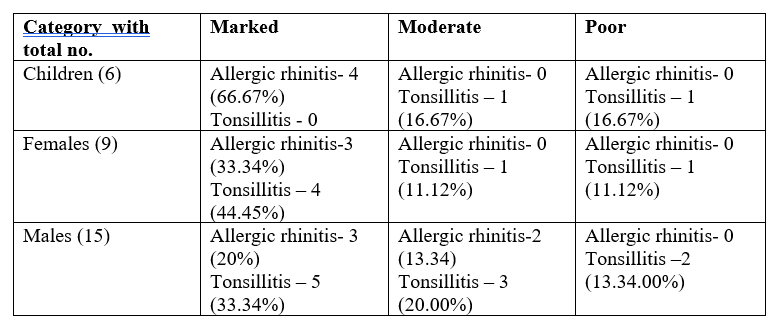
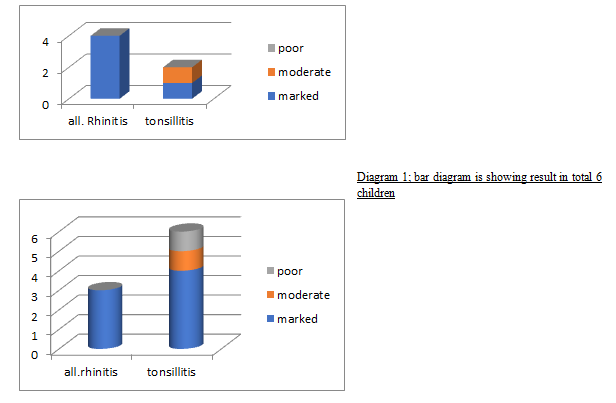
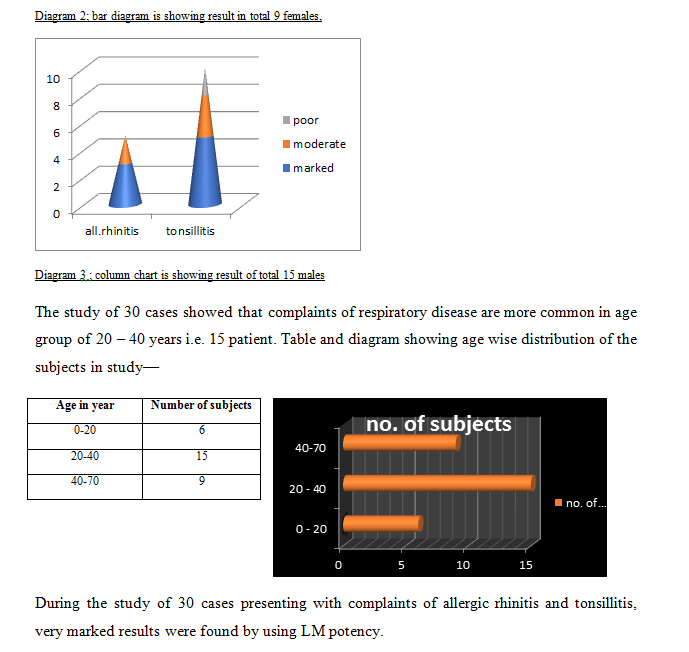
As in allergic rhinitis it shows:
i) Marked result- 73%, ii) Moderate result -20%, and iii) Poor result– 7%
As in tonsillitis cases it shows:
i) Marked result- 60%, ii) Moderate result -27%, and iii) Poor result – 13%
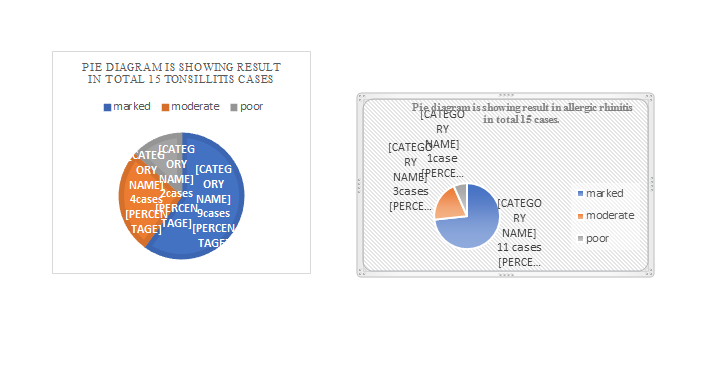
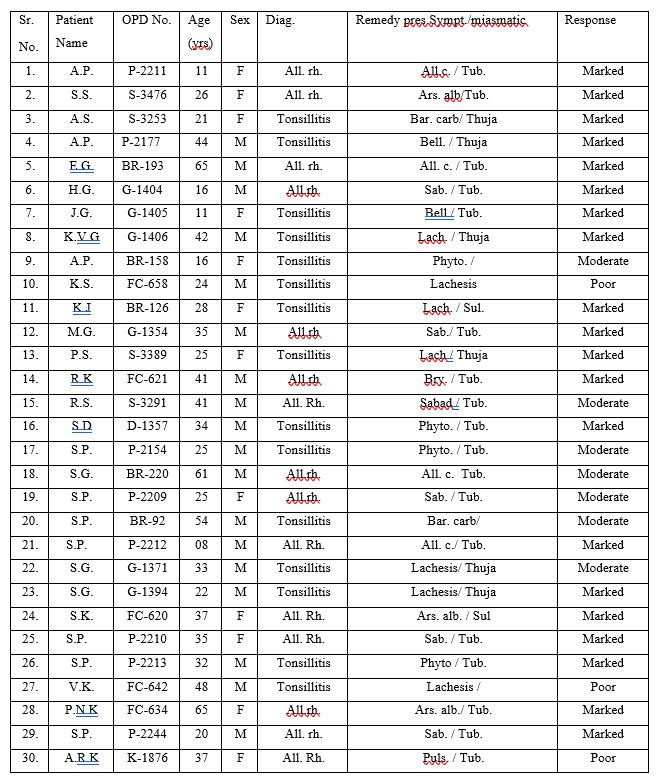
DISCUSSION : I have selected allergic rhinitis and tonsillitis in the study. 30 cases were taken for the study.
- Age group ratio: It is most commonly seen in age group of 20-40 years i.e. 15 patient, 50% in age group of 0-20 years i.e. 6 patients 20% and 40-70 years i.e. 9 patient, 30% each.
- Remedies prescribed: During the study of 30 cases, it was found that in 15 cases allergic rhinitis, Allium cepa, Arsenicum album, Sabadilla are most commonly prescribed, and in cases of tonsillitis, Lachesis mutus, Phytolacca decandra and Belladonna are most commonly prescibed remedies. Other medicines used were Rhus toxicodendron, Colocynthis, Causticum and Calcarea phosphoricum, etc. Thuja occidentalis, Tuberculinum and Sulphur are prescribed as antiimiasmatic remedies to cure miasmatic obstacle.
At the end of my study it was seen that along with the homoeopathic medication and strict auxiliary line of treatment complaints of respiratory disorder can be very well managed.
- CONCLUSION : LM potency has a very good scope in management of complaints of respiratory disorder. The study was very enthusiastic and patient showed marked improvement by using LM potency. From this study, it was seen that repetition is required in most of the cases and by giving LM potency it was very easy to restore the patients who are suffering from diseases from a long time. LM potency does very rapid, gentle and permanent cure to this type of chronic cases.
REFERENCE
- 1. Chaoudhury H., 50 Millisemal Potency in Theory and Practice, 3rd reprint edition, B Jain Publishers (P) Ltd., New Delhi; 1999.
- Dey S.P., Essentials of Principles & Practice of Homoeopathy, 2nd edition, published by Dr. Mrs. Sabita Rani dey, Calcutta; 1989
- Hahnemann S., The Chronic Diseases, their peculiar nature and their Homoeopathic cure, 1st NCBA edition, New Central Book Agency (P) Ltd. Kolkata; 2007.
About the author:
Dr Purusottam Kumar Singh MD (Hom.- Organon of Medicine)
Assistant Professor, Dept. of Organon of Medicine
Government Homoeopathic Medical College & Hospital
Paraspani, Godda- 814147 (Jharkhand)



